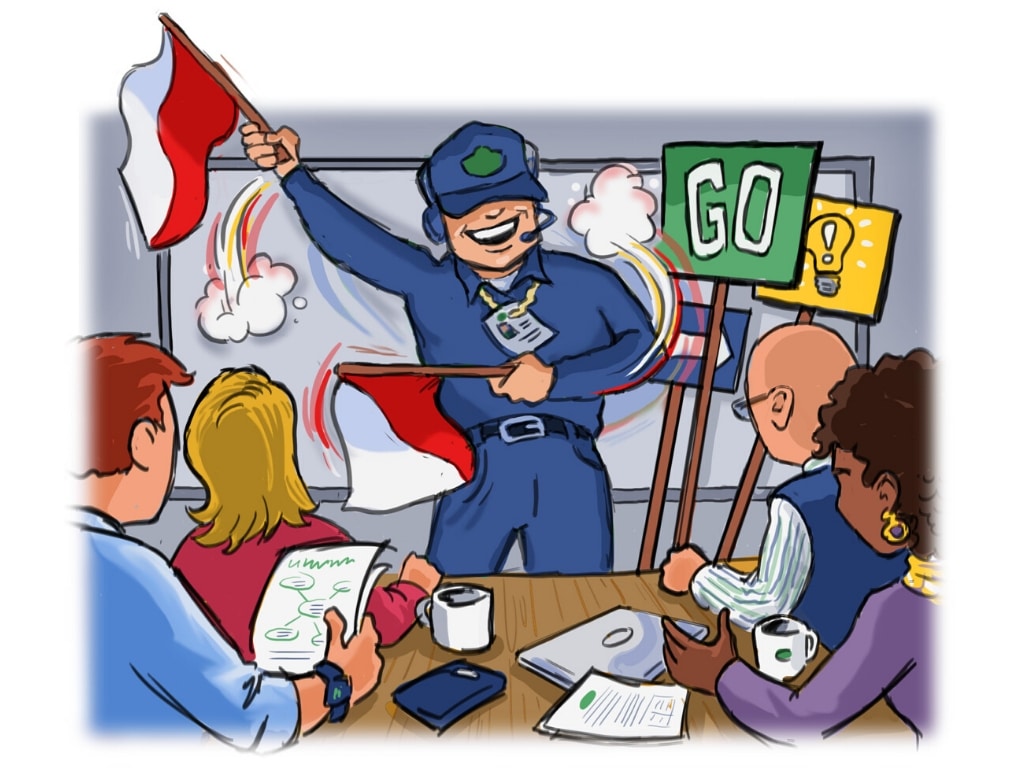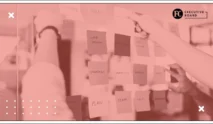We’ve all been there. Sitting in that dreary room, feeling as though the minute hand on your watch has gotten stuck. Time seems to stop, and you’re left hoping – even praying – that it’ll all be over soon, that you can escape the beige prison that currently encases you.
The terror I am referring to? Why, a typical corporate meeting, of course!
Unfortunately, meeting and presentation dread has become a common occurrence at offices around the globe. What should be treated as a collaborative, creative experience is reduced down to nothing more than a dull regurgitation of facts and figures with zero collaboration.
But it doesn’t have to be this way! In fact, by using effective meeting strategies, you can take those bad presentations and turn them into amazing, thought-provoking, magical gatherings, ones that drive your mission and your organization forward, and ones that you and your team actually look forward to attending.
How Did Meetings Get So Bad?
First things first – it’s important to understand why our meetings and presentations have gotten so bad. It all goes back to when we were kids…
When we were young, we had amazing little minds and imaginations that we instinctively used to think “Expansively.” It was this expansive thinking that allowed us to turn a cardboard box into a spaceship or a fort, make up an imaginary language with an imaginary friend, or invent new games on the fly.
But then one day, along came school. Soon enough, we had teachers telling us that our favorite spaceship is “just a box,” and in that split second all of our creativity and imagination started to crumble. This would go on to be compounded by traditional education and employment, where we were taught to think “Reductively” instead of Expansively, meaning that the endless leaps and bounds of our imaginations were reeled in and confined.
This is why so many people believe they are not creative, and why presentations – what could and should be an incredibly creative act – have been reduced to the lowest common denominator: an hour-long reductive speaking session with zero spark, imagination, or creativity.
So, how might we fix this? With effective meeting strategies!
Start with Signaling
One of the biggest problems with today’s standard corporate presentations is with their Signaling.
Whether you realize it or not, every little thing you do signals others how to behave. This is especially true when it comes to meetings. While we may think our presentations are going to inspire creativity and innovation, most meetings traditionally signal attendees to do the exact opposite.
For example, look at the word “Presentation.” What does that signal? Does it tell you that you’re entering a safe, collaborative environment full of expansive thinking, or one where a single person is going to be speaking at you?
It’s the latter, correct? Just by calling it a “Presentation” we are already signaling to others to think reductively instead of expansively. So instead, look at ways to signal creative, expansive thoughts.
At Pixar – arguably one of the world’s most creative companies – they regularly hold “Plussing” meetings, where no ideas are allowed to be shot down. Instead, the only way to participate is to “plus” an idea, adding something on to what was originally shared. As the meeting progresses, ideas get larger, bolder, and more innovative, merely because everyone that steps foot into a “Plussing” meeting knows that it’s time to think expansively.
Just as the title of your meeting can signal certain behaviors, so can the room itself. With my work as the Head of Innovation and Creativity for Disney, as well as my consulting work that takes me across the globe, I have stepped foot into literally thousands of meeting rooms. And with the exception of a handful of wonderfully creative corporations, almost every meeting room has the same style – a standard boilerplate design that oozes reductive thinking.
Why not use the room to signal expansive, creative thoughts? HSBC Shanghai is a wonderful example of this behavior. Looking to make meeting rooms more welcoming to creative and innovative thoughts, they reached out to a local art college and asked them to come make over a meeting room. The result was a beautiful “greenhouse” meeting room that the students designed – a space so unique and different that every HSBC employee that sets foot in that room knows it’s time to share and build creative ideas.
Almost every office has an art school within 5-10 miles, and a professor looking for unique projects to give her students. How could you transform your space with such a partnership, and start signaling creative, expansive meeting behaviors?
The Room Setup
Another major signal your presentations send is through the way the room is set up. Think about almost every meeting you attend. Chances are, you and everyone else are separated by a large glass or oak table, right? What does this separation signal?
Have you ever seen American Idol?
Those judges are all situated behind a big table, aren’t they? In fact, nearly every game and talent show features judges separated from contestants by a large table or podium, just as real-life judges and juries are separated from defendants by tables and podiums.
When we place objects between us and the other meeting attendees, we are signaling that this is a presentation to be judged. It’s not a collaboration or team exercise – it’s us vs. them.
Get out from behind the table, and you’ll be amazed at how quickly your presentations turn from a competition into a spark-provoking collaboration.
The Presentation
Of course, the biggest signal you send in a meeting is the style of the presentation itself.
Show of hands…how many of you have given a presentation via PowerPoint?
That’s what I thought. We’ve all been there. But ask yourself: are you reading off a bunch of slides signaling the right type of behavior to the rest of your meeting attendees? Most likely not!
In fact, most of the corporate world has become conditioned to treat PowerPoints like a challenge, something we need to poke holes in to show our worth at the company. The more I object, the more I get noticed by my boss, right? It’s the same signal you send with the table. I present and you judge.
So, how might we flip the script? Simple – use your effective meeting strategies and get off the screen and onto the page. Print your presentations and set them up like a storyboard. Walt Disney, arguably one of the greatest presenters and storytellers of all time, relied on this method religiously.
Create a sequence of boards around the edge of the room, and then walk your attendees from point to point. With the table gone and the PowerPoint shut off, this method signals a completely different behavior. Now, we’re a team moving through the ideas together. There’s no reductive feedback or shutdowns. Just expansive “plussing” and collaboration.
How to Handle Objections
Of course, even with all these new signals, you’ll still find the occasional disruptive meeting participant, one that voices their reductive thoughts louder than anyone else and creates a tension that can risk derailing your entire presentation.
Fortunately, these dissenters can be dealt with in a variety of non-confrontational ways. Here are a few of my favorite tactics:
Rephrase the Question
Typically, we end our presentations with “What do you think?” The problem with this is that more often than not, people have the annoying habit of actually telling us the truth. The phrasing of the question signals them to poke holes in our ideas.
Instead, phrase your questions in a collaborative manner. “Could you help me build on this idea or think about it in a different way?” is still asking for feedback, but in a way that signals we’re all on the same team. It drives expansive thoughts and collaborative “plussing” behaviors.
Give Out Penalty Cards
For meetings and presentations that are meant to be expansive and full of innovative thoughts, create a penalty card system similar to football (or soccer for my American friends). Anyone caught trying to poke holes in ideas or otherwise turn the meeting into a typical, reductive thought-driven affair is immediately given a yellow card by the organizer. Receive more than one yellow, and you’ve got yourself a red card, and are asked to leave the meeting.
You’ll be amazed at how quickly behavior shifts and disruptive participants quiet down when they fear getting that yellow card!
Bring Out the Gorilla Mask
One of the best tools I have ever witnessed was a simple rubber gorilla mask lying in the center of the conference room table. During expansive thought meetings, anyone caught interrupting with unproductive challenges and put-downs was asked to reshare their reductive thought, but with the gorilla mask on.
Needless to say, no one wanted the embarrassment of having to wear a silly mask in front of their colleagues, and thus it served as a constant reminder throughout the meeting that only positive, expansive thoughts were welcomed here.
Presentations Can Be Wonderful Tools
While many of us have been conditioned to dread meetings and presentations, we shouldn’t give up all hope yet. These gatherings can actually be some of the most fruitful minutes and hours of your day…if they’re approached correctly.
Remember that the best presentations are not presentations at all, but a conversation, a collaborative gathering of minds, where everyone in the room builds on one another, sharing expansive, innovative thoughts that drive ideas, your team, and ultimately, the organization forward.
As you prepare for your next presentation at work, ask yourself how you can go about signaling behavior in a way that best serves the meeting. With effective meeting strategies and a few subtle changes, you’ll be amazed at how quickly the dynamic can shift, and how soon your teams will come to love meetings once again.




